Sagadahoc Story #64: 11/3/98
The wind in the trees
The weather turned raw for hunting season, after a dose of mild
days and starry nights. The deer shoot started Saturday, Halloween,
which has to be one of the stupidest decisions on record. Take
every child in the state, put them in masks, get them cranked
up on sugar, and send them out along the roads at dusk. Then pour
a full tot of good old boys into their pickups and send them out
with rifles to chase shadows. Miraculously no kids were reported
bagged.
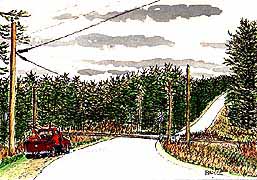
Hunters at Crossing |
We drove up to Litchfield Saturday afternoon, and hunting sign
was everywhere. Pickups on the shoulders willy nilly. Armed men
in blaze orange walking perimeters. Fourwheelers waiting to drag
out the carcass. Heightened alertness in the air. Not a deer in
sight.
|
New views are unfolding. The trees have shaken off their solar
collectors, and dropped into the sleep mode. The farther hills
and hidden valleys of Summer appear between the bare boles, and
all the house starts stick out. You have to feel for the folks
who went in during high foliage, flattened a houselot, and installed
a doublewide in the privacy of the woods, only to discover another
new house within sight when the leaves have fallen. The upper
end of the Post Road looks like a rolling sea of trailers, now
the picture is ungreened. Brent says there's a hundred trailers
up the old road. At least we're safe from suburbanization.
It's a commentary on our priorities that all the new low rent
dwellings in these boonies are manufactured housing. Brent and
Bruce and Dr. Bob are now constructing a small building down on
Mere Point, 20X24, two story. What could be a charming starter
home (it's actually an outbuilding), with unlimited expansion
potential. $30,000. That's as much footage as a trailer, and a
whole lot more character. There could be crews of carpenters putting
up the rustic cape-and-els of the future, to grace the landscape,
instead of tractors hauling in bland ephemera. But we're convinced
that a stickbuilt home is beyond modest means, and most carpenters
are building mansions on the shore.
| As the hidden landscape exposes itself, I'm seeing new things
in the renderings, too. I've made a stab at drawing the wind in
the trees, and found my paintings opening up, as the woods are.
Part of it's a result of using digiOlympus. As the weather's cooled
off, I'm more likely to be snatching glimpses with the camera,
and then painting from prints. It changes the paintings. Media
informing each other, again. |
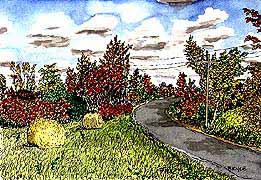
Rolls on the Curve |
At first I struggled to get high resolution photos, which ain't
easy with a digital camera, even with a 1.4Meg image. At close
range in good light these wonder tools grab images that print
well up to 8X10, but wide angle landscapes or marginal conditions
leave you begging for a chemical SLR. As with all new tools, you
try and replicate what the old tools could do, and are disappointed.
Then you start exploring the medium, and discover new ways of
looking. I was so busy trying to take electronic slides, I hardly
noticed that I was making pixilated prints. Or how lush and tactile
they can be.
Similarly, I was doing contortions to get big file images of subjects
I wanted to paint. I'd go out with the camera set at the low res,
shooting at will, until I found a likely image. Then I'd switch
to the highest resolution, and try to get the perfect picture.
Sometimes I did get a print quality photo, but more often I was
disappointed. This camera can only store 4 big shots on it's card.
I carry a spare card, but that still limits me to 8 pictures per
outing, if I insist on hi res. And the download line is brutal.
I can take 98 quickies at the low end. It wasn't until I accepted
the limitations of the technology that it started to work for
me. I found I could take low res snaps (146K: 640X510 pixels)
from a variety of angles, enhance them in the software (Photoshop),
print the picture, and have a rough framework to paint from.
I've gotten over the feeling that painting from photos is cheating.
I frame the shots to suit the camera, of course, and tend to use
the same composition for the drawing. But I can still crop and
edit the scene to fit the different medium. The act of translation
from eye to hand to eye doesn't change in essence. What does change
with using these low res takes, is the density of detail I'm working
from. The seen world is infinitely rich at all levels of examination.
Extracting a telling semblance from the myriad details is the
al fresco fandango. You dance to a different tune with photos.
Most of the image in these printed pictures is a graduated pattern
of blurs. To accomplish the dense linear mesh that's become my
style I have to invent the details. Where I was reducing a seamless
manifold to a handful of gestures, now I'm using learned gestures
to fill out a vague patterning. The product looks much the same,
but the technique is inside out.
The two different approaches enrich one another. Going out to
paint teaches me the strokes that capture reality. Going in to
paint shows me the elemental structure of the scene, and dissolves
the mesh so other fish can swim through. I first saw the effect
of this new seeing with the Hobart Farm drawing. The photo was sparse on detail, and I'd built up the
line drawings of the trees from an inner memory of maples and
oaks. When I washed on the colors, I was unusually light-handed,
influence by the thin colors in the print I was looking at. Leaving
out all the dense color in a foreground tree caused it to light
up, the way the actual tree had been illuminated by its brilliance.
KAPOW. When I was done there was hardly any pigment in my water
jar.
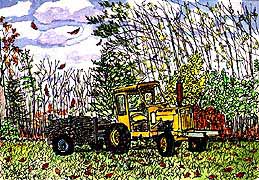
Firewood Tractor |
I've known all along that a masterful watercolorist lets the paper
shine through, but damned if I could leave it alone. The world
was too thick and thingy to leave the paper blank. By filtering
the world with a camera, I'd begun to let a little light into
my paintings. Whoda thunk? And if the light can get in, what about
the air? I set about finding a view that would mimic the feeling
of falling leaves and naked branches sighing. Of course there
ought to be some good manjunk in the foreground. In the end I
took a picture of a woods tractor in a lot. But the background
was of thick woods. So I thinned the trees, and opened out the
sky. A wind knocked the leaves loose. |
Fall can do that: strip you a little bare so new things show through.
A good time to tear it down and move the ingredients around, too.
That's what the town's doing. At town meeting we voted to buy
the old fertilizer mill on the riverbank to use as a municipal
facility, and the Frizzle boys are up to their public works in
demolition and cartage. Last Sunday week Doug took his machinery
to the backside of the mill and shoveled a hunk of it into a burn
pile. Monday the fire department torched it. The remains smoldered
until Thursday. Ironically, we used to say that the worst nightmare
was having that mill burn, and kill us all with toxic smoke. In
the end all we suffered was the stink of cooked asphalt. Now they're
trucking the winter sand pile onto the cleared slab. Nice to see
our taxdollars moving a pile of dirt that's going to be spread
on the roads anyhow.
|
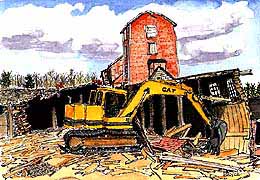
Mill Demolition |
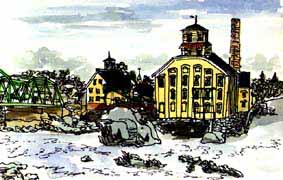
Bowdoin Mill (1997) |
When the old mill is completely gone there'll be another gaping
hole in the center of town. Everyone in eyeshot seems to think
that'll be glorious. Clearcut the landing, flatten the old buildings.
I must be an oddball to think romantic eyesores and abandoned
buildings are more interesting than tidy parking lots. Another
crew has started demolishing the big wooden mill buildings at
the falls in Brunswick. A project to resurrect the heart of the
Bowdoin Mill is finally going to happen, and that 19th century
yellow brick landmark is going to be restored, after they bulldoze
the surrounding structures. Score one for esthetics. |




